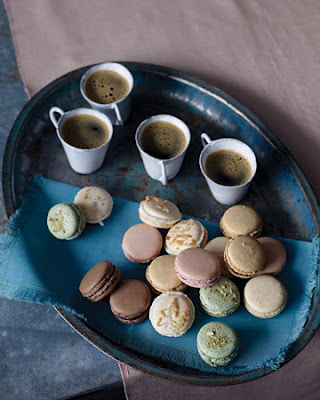Multicoloured Macaroons
Macaroons are coming back into fashion in a big way.Carefully follow the recipe for perfect macaroons that will wow your guests.
Ingredients
175g icing sugar
125g ground almonds
3 large free-range egg whites
75g castor sugar
For the filling
150g butter, softened
75g icing sugar
Method
1. Preheat the oven to 160°C/fan140°C/gas 3. Whizz the icing sugar and ground almonds in a food processor to a very fine mixture, then sift into a bowl.
2. In a separate bowl, whisk the egg whites with a pinch of salt to soft peaks, then gradually whisk in the castor sugar until thick and glossy. (At this point you can stir in flavour extract, such as peppermint or lemon, and corresponding colouring such as blue or yellow, to your meringue mixture, depending on what kind of macaroons you want – see chef's tip. Or divide the meringue among different bowls if you want to make more than one colour.)
3. Fold half the almond and icing sugar mixture into the meringue and mix well. Add the remaining half, making sure you use a spatula to cut and fold the mixture until it is shiny and has a thick, ribbon-like consistency as it falls from the spatula. Spoon into a piping bag fitted with a 1cm plain nozzle.
4. Line 2 baking sheets with baking paper. Pipe small rounds of the macaroon mixture, about 3cm across, onto the baking sheets. Give the baking sheets a sharp tap on the work surface to ensure a good ‘foot’. Leave to stand at room temperature for 10-15 minutes to form a slight skin. This is important – you should be able to touch them lightly without any mixture sticking to your finger. Bake for 15 minutes. Remove from the oven and cool.
5. Meanwhile, make the filling/s (unless making chocolate macaroons – see chef's tip). In a bowl, beat the butter until light and fluffy, then beat in the icing sugar. (You can now add flavouring or nuts, and colour – see chef's tip.) Use to sandwich pairs of macaroons together.
Nutritional info
Per macaroon: 160kcals, 9.7g fat (4.2g saturated), 1.8g protein, 17.5g carbs, 16.4g sugar, 0.2g salt
Chef's tip
Macaroons taste wonderful plain, but why not add flavouring and colouring? Flavour extracts – such as raspberry, lemon and peppermint. Flavourings and colourings are available in supermarkets and cake shops. To flavour and colour your macaroons, in step 2, add around ½ tsp flavour extract, then add the appropriate colouring, a drop at a time, until you reach the desired intensity. Flavour and colour the buttercream in the same way. For chocolate macaroons, replace a quarter of the icing sugar with cocoa powder and use Nutella as the filling. For pistachio macaroons, replace half the ground almonds with ground pistachios (whizz in a blender or finely chop by hand), and use green food colouring to achieve a pastel green. Fold chopped pistachios through the filling, if you like.
History of macaroon
A macaroon is a sweet confectionery made with egg whites, icing sugar, granulated sugar, almond powder or ground almond, and food coloring. The macaroon is commonly filled with buttercream or jam filling sandwiched between two cookies. Its name is derived from an Italian word "maccarone" or "maccherone". This word is itself derived from ammaccare, meaning crush or beat, used here in reference to the almond paste which is the principal ingredient.It is meringue-based: made from a mixture of egg whites, almond flour, and both granulated and confectionery sugar.
The confectionery is characterized by its smooth, domed top, ruffled circumference (referred to as the "foot"), and flat base. It is mildly moist and easily melts in the mouth.
Macaroons can be found in a wide variety of flavors that range from the traditional (raspberry, chocolate) to the new (truffle, green matcha tea). The fillings can range from jams, ganache, or buttercream. Since the English word macaroon can also refer to the coconut macaroon, many have adopted the French spelling of macaron to distinguish the two items in the English language. However, this has caused confusion over the correct spelling of the cookie/biscuit. Some recipes exclude the use of macaroon to refer to this French confection while others think that they are synonyms.
Although predominantly a French confection, there has been much debate about its origins. Larousse Gastronomique cites the macaron as being created in 791 in a convent near Cormery. Some have traced its French debut back to the arrival of Catherine de' Medici's Italian pastry chefs whom she brought with her in 1533 upon marrying Henry II of France.
In the 1830s, macarons were served two-by-two with the addition of jams, liqueurs, and spices. The macaron as it is known today was called the "Gerbet" or the "Paris macaron" and is the creation of Pierre Desfontaines of the French pâtisserie Ladurée, composed of two almond meringue discs filled with a layer of buttercream, jam, or ganache filling.
Source: Recipes & pictures from Google







Salam noor - You did it??Please share with me...or this weekend we do it again :)
ReplyDeleteLooking forward to bake these together...InshaAllah.
ReplyDeleteTips:Leaving the oven door ajar with a wooden spoon is a fantastic way to get a nice unburnt color on your macaroons.